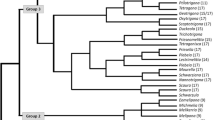XII. Summary
Normal somatic complement inA. indica consists of 32 chromosomes in female and 16 in male. Karyo-typic analysis of haploid males shows eight homomorphic pairs indicating distinct somatic association (2m.c.+2s.m.c.+4s.t.c.).
Excepting the gonial and epithelial layers of blastoderm, other tissues show polysomatic increase in euploid or aneuploid numbers through repeated endomitosis.
In view of occurrence of eight homomorphic pairs in the male showing somatic association, it is inferred that the male, thoughj numerically haploid is genetically diploid thus the famale being a tetraploid. This is supported by control of certain characters by multiple genes without linkage and diploid, constitution ofA. florea having 16 chromosomes in female and 8 in male.
It is suggested thatA. indica originated from primitive diploid by (1) polyploidy combined with adaptive mutations for multiple enclosed comb habits or (2) hybridization at diploid level among closely relatedApis andTrigona followed by polyploidy during pleistocene glaciation in the Indo-Malayan region.
PrimitiveA. indica gradually evolved intoA. mellifera which differentiated further into a number of African, Eurasian and Sino-Japanese races during the course of the passage through the three main northern migratory routes of the Himalayas.
Bearings of these observations on the practical problems of breeding better strains of Indian bees are discussed.
Investigations on comparative cyto-genetics of Indian species ofApis, Trigona and related genera are in progress.
Similar content being viewed by others
XIV. Literature Cited
Alpatov, W. W... “Über die Verkleinerung der Russellange der Honigbiene vom Suden nach dem Nordenbin,”Zool. Anz., 1925,55, 103.
Armbruster, L... “Chromosomenverhaltnisse bei der Spermatogenese solitarer Apiden (Osmanai cornuta Latr.),”Arch. Zell-forsch., 1913,11, 242–326.
Granata, L... “Le divisioni degli spermatociti diXylocopa violacea L.,”Biologica (Torino), 1909,2, 1–12.
Hatch, M. H. .. “The origin and evolution of the honey-bee,”Amer. Bee Jour., 1950, 90–226.
Hochinohe, Y. and Onishi, N. “Meiosis in drone honey-beeApis mellifica,”Bull. Nat. Inst. Agri. Sci., Ser. G, 1952, 3–83.
Kerr, W. E... “Estudos sobre o genero Melipona,”Anais Escola super, Agr. ‘Luiz de Queiroz’, 1948,5, 181–276.
—————.. “Sex chromosomes in honey-bee,”Evolution, 1951,5, 80.
----- .. “Variation in the number of chromosomes in the evolution ofHymenoptera,”Bee World, 1952, 36–131.
—— and Hans, R... “Sex determination in the honey-bee,”Evolution, 1952,6, 444.
—— and Laidlaw, H. H. “General genetics of bees,”Advances in Genetics, 1956,8, 109–53.
Lindauer, M... “Communication between honey-bees and stingless bees of India,”Bee World, 1957,38, 3.
Linnaeus, C. .. “Sustema naturæ per regna tria naturæ, secumdum classes, ordines, genera, species,cum characteribus, differentiis, synonymis, loci, Editio, decima, reformata, Tomus I,”Laurentii Salrii, Holimaæ, 1758.
Mackensen, O... “Viability and sex determination in the honey-bee (Apis mellifera L.),”Genetics, 1951,36, 500–09.
Makino, S. ..An Atlas of the Chromosome Numbers in Animals, 1st Am. Ed., Iowa State College Press, Ames, 1953.
Manning, F. J... “Sex determination in the honey-bee,”Microscope, 1950,8, 129.
Michailoff, A. S... “Über die geigraphische variabilitat der Honigbiene im ebenen europaischen,”U.S.S.R. Zool. Anz., 1928,77, 29–36.
Michener, C. D... “Observations on the pupæ of bees,”Pan-Pacific Entomol., 1954,30, 63–70.
Muttoo, R. N... “Editorial—Naming the Indian Bees,”Indian Bee Journal, 1951,13, 58.
Nachtsheim, H... “Cytologische Studien uber die Geschlechtsbestimmung der Honigbiene (Apis mellifica L.),”Arch. Zell-forsch., 1913,11, 169–241.
Petrunkewitsch, A... “Die Richtunskorper und ihr Schicksal im befruchteten und unbefruchteten Bienenei,”Zool. Hahrb. Abt. Anat. u. Ont., 1901,14, 573–608.
Roberts, W. C. and Mackensen, O. “Breeding improved honey-bees,”Amer. Bee Jour., 1951,91, 292–94; 328–30, 382–84, 419–21, 473–75.
Rothenbuhler, W. C... “Five mutant genes in morphic honey-bees (Apis mellifica),”Genetics, 1952,37, 620.
Ruttner, F. and Mackensen, O. “The genetics of the honey-bee,”Bee World, 1952,33, 53–62, 71–79.
Sanderson, A. R. and Hall, D. W. “The cytology of the honey-bee—Apis mellifica L.,”Nature, 1948,162, 34–35.
Schwarz, H. F. .. “Stingless bees (Meliponidæ) of the Western Hemisphere,”Bull. Amer. Mus. Nat. His., 1948,90.
Smith, F. G... “Notes on the biology and waxes of four species of AfricanTrigona bees (Hymenoptera, Apidæ),”Proc. Roy. Entomol. Soc. London, 1954,29, 62–70.
Suomalainen, E... “Parthenogenesis in animals,”Advances in Genetics, 1950,3, 193–253.
Tokuda Yoshinoba.. “Studies on the honey-bee, with special reference to the Japanese honey-bee,”Bul. Imp. Zoo. Exp. Sta. (Japan), 1935,15, 1–27.
Whiting, P. W... “Multiple alleles in complementary sex determination ofHebrobracon,”Genetics, 1943,28, 365–82.
—————.. “The evolution of male haploidy,”Quart. Rev. Biol., 1945,20, 231–60.
Author information
Authors and Affiliations
Additional information
Communicated by Prof. L. S. S. Kumar,f.a.sc.
Rights and permissions
About this article
Cite this article
Deodikar, G.B., Thakar, C.V. & Shah, P.N. Cyto-genetic studies in Indian honey-bees. Proc. Indian Acad. Sci. 49, 194–206 (1959). https://doi.org/10.1007/BF03051656
Received:
Issue Date:
DOI: https://doi.org/10.1007/BF03051656




